Automobile Pioneers of the Boston-Edison Historic District
John N. Anhut
 John Nicholson Anhut was born in 1884. In 1908 he was elected to the Michigan state Senate, at the time the youngest member of the legislature. In 1909 he founded the Anhut Motor Car Company along with Detroit mayor Philip Breitmeyer. However, Anhut relinquished control of the company the next year to concentrate on his upcoming re-election, and it went bankrupt soon after. Anhut lost his election, moved to New York, and studied for the bar. However, in 1912, he was found guilty of bribery and sentenced to four years in prison. Anhut returned to Detroit and established a law firm. In the 1920s and 30s, he was involved in the hotel industry, owning both the Imperial and Clifford hotels in downtown Detroit, as well as being the attorney for the Detroit Hotel Association. He died in 1977.
John Nicholson Anhut was born in 1884. In 1908 he was elected to the Michigan state Senate, at the time the youngest member of the legislature. In 1909 he founded the Anhut Motor Car Company along with Detroit mayor Philip Breitmeyer. However, Anhut relinquished control of the company the next year to concentrate on his upcoming re-election, and it went bankrupt soon after. Anhut lost his election, moved to New York, and studied for the bar. However, in 1912, he was found guilty of bribery and sentenced to four years in prison. Anhut returned to Detroit and established a law firm. In the 1920s and 30s, he was involved in the hotel industry, owning both the Imperial and Clifford hotels in downtown Detroit, as well as being the attorney for the Detroit Hotel Association. He died in 1977.
John Anhut lived at 100 Longfellow from the 1930s through the 1950s.
Clarence W. Avery
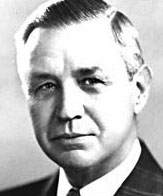
Clarence Avery was born in Dansville MI, in 1882. He became a teacher of manual training, working in Battle Creek and Ishpeming before becoming director of manual training at the Detroit University School in 1907. In 1912, one of his students, Edsel Ford, introduced Avery to his father. Henry Ford, seeing potential in Avery, hired him for a summer job. Avery learned quickly, and soon left his teaching job to become Charles E. Sorensen's assistant. Beginning in 1913, Avery and Sorensen focused on developing the moving assembly line. Although the originator of this idea is uncertain, Avery certainly had the biggest hand in developing it. By timing each step to maximize the speed of production, Avery and Sorensen reduced the assembly time of the Model T from 12.5 hours to 2.7.
As the company grew, Avery worked as Ford's chief development engineer, developing a reputation as a problem-solver. He developed methods to increase the clarity of automotive glass, and ran Ford's operations in northern Michigan for a time.
In 1927, Avery resigned to join Murray Body Corporation, an automobile body manufacturer (and Ford supplier) that was then recovering from bankruptcy. Avery began as an assistant to then-president William R. Wilson, but quickly became president or Murray and eventually Chairman of the Board. He remained with Murray, successfully steering the firm, until his death in 1949.
In 1918, Avery moved to 1626 W. Boston Boulevard, living there until the early 1920s.
Read more about Clarence Avery at the Automotive Hall of Fame, and Murray Body Corp.
Andrew Bachle
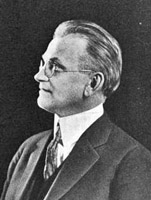
Andrew Bachle was born in Norwalk, Ohio in 1866. He attended Northwestern University and graduated as a mechanical engineer. After graduation, Bachle worked as a traveling sales representative for a Cleveland manufacturing firm for 14 years. In 1899 he married Mary C. Smith. In 1904, he came to Detroit and took a job as chief engineer for Reliance Motor Truck. In 1909, he moved to the same position at Paige-Detroit, eventually becoming vice-president of the firm, a position he held until he retired in 1927.
Andrew Bachle had a house built at 1406 W. Boston Boulevard, where he lived from the late 1910s until his death in 1930. The house has been since demolished due to construction of the Lodge Freeway.
William B. Bachman
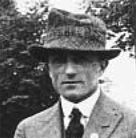
William Bachman came to Detroit in 1910 to manage a dry goods store. During a motoring excursion in 1912, where he led over 150 Detroiters to the Indianapolis Speedway, Bachman hit on the idea of marking routes by banding telephone poles at intersection. Upon returning to Detroit, Bachman and the Detroit Auto Club put his plan into action, creating the nation's first road marking system. In 1916 Bachman, with other men, founded the Automobile Club of Michigan, which became the largest Auto Club in the world through his 44 years as membership director. In 1923, Bachman lobbied for designation of major throughways in Detroit to be designated "main streets," where cross traffic would be required to stop. The City Council so designated Michigan, Woodward, and Grand River, and Bachman and the Detroit Auto Club installed the then-novel "stop signs" to warn traffic.
William Bachman lived at 803 Longfellow in the early 1920s, moving to 1130 W. Boston Boulevard in the late 1920s, where he lived until his death in 1967.
George M. Bacon

George M. Bacon got his start in the automobile manufacturing business at the Columbus Buggy Co of Columbus Ohio, joining the company in 1904 as chief engineer. Columbus Buggy's president and vice-president were Clinton D. and Joseph F. Firestone, Harvey S. Firestone's father and brother (Harvey had worked for the company a decade earlier). Other significant employees of Columbus Buggy included Lee Frayer and Eddie Rickenbacker. The company began producing electric automobiles in 1905.
In 1907, George M. Bacon left Columbus Buggy and teamed up with carriage-maker William C. Anderson to build an electric car, with Bacon as chief engineer and designer. The effort was originally part of Anderson Carriage Company, but as their electric vehicle production grew, the company changed its name to the Anderson Electric Car Co, and, in 1919, to the Detroit Electric Car Company. The Detroit was the best-known of American electric cars, and by the time they folded in 1939 had produced around 30,000 automobiles.
In 1922, while at Detroit Electric, Bacon designed an electric milk truck. Although the truck had several good features, the electric motors of the time weren't sufficient to adequately power the vehicle, and Detroit Electric wasn't interested in producing a gasoline-powered truck. Instead, Bacon resigned from Detroit Electric, gathered several investors, and in 1924 started the Detroit Industrial Vehicle Company (DIVCO), using his electric design as the basis for a more powerful gasoline-powered truck. DIVCO began producing milk trucks in 1926. The company was hit hard by the Depression, and in 1932 was bought out by Continental Motors, one of its suppliers. Although the company subsequently changed hands multiple times, they continued to produce trucks until 1986.
George M. Bacon lived at 161 Longfellow in the 1910s and 1920s.
Read more about the Detroit Electric Car Co. and DIVCO.
John Ballantyne
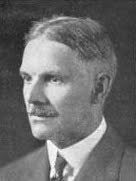 John Ballantyne was born in 1868 in Paisley, Scotland. He went into banking there, but in 1891 moved to Detroit to manage the credit office of R.G. Dun & Company (a predecessor to Dun & Bradstreet). He was also manager of the local branch of the Wilbur Mercantile Agency, and in 1909 moved to the Old Detroit National Bank to manage their credit department. He was elected vice-president in 1912. In 1914, Ballantyne started a new bank, the Merchant's National Bank, of which he was president, and later chairman.
John Ballantyne was born in 1868 in Paisley, Scotland. He went into banking there, but in 1891 moved to Detroit to manage the credit office of R.G. Dun & Company (a predecessor to Dun & Bradstreet). He was also manager of the local branch of the Wilbur Mercantile Agency, and in 1909 moved to the Old Detroit National Bank to manage their credit department. He was elected vice-president in 1912. In 1914, Ballantyne started a new bank, the Merchant's National Bank, of which he was president, and later chairman.
Ballantyne was also a close personal friend of both John and Horace Dodge, and in 1920, after the death of both brothers, Ballantyne was elected as director of the Dodge Brothers Motor Company. He was treasurer of the company, and facilitated the sale of the company in 1925.
In 1929, the Merchant's National Bank merged with the Dime Savings Bank to form the Bank of Michigan, with Ballantyne as chairman. The bank merged a number of times in the early 1930s, and Ballantyne retired. In 1933, Ballantyne formed another bank, the Manufacturer's Bank of Detroit, and served as president. (Manufacturer's Bank merged with Comerica in 1992) Ballantyne remained president of the bank until his death in 1937.
John Ballantyne lived at 2275 Chicago in the 1930s.
Harry L. Bill
Harry L. Bill was born in Connecticut in 1882, and after finishing school began a career in manufacturing. He joined the Winchester Repeating Arms Company, then jumped into the then-new area of automobiles, joining the Corbin Motor Company in New Britain. He transferred to Detroit, where he was manager for Chalmers Motor Company, and later moved to be a manager for the Winton, Saxon, Metzger, and finally Tudhope Motor Car Companies. He later moved into the aviation industry, becoming a manager for Bendix Aviation in Brooklyn, New York. In 1939, he moved to United Aircraft Products, and in 1941 became general manager of Greeffield Tap & Die in Connecticut. He remained in that position until his death in 1954.
Harry L. Bill lived at 10 Longfellow in the early 1920s.
Charles L. Bockus
 Charles L. Bockus was born in 1867 in Quebec. He became a machinist, and eventually joined Studebaker. There, he became a foreman, superintendent, and then a plant manager. In 1917 he became the general manager in charge of production for Studebaker, a post he held until ill-health forced him to retire in 1936. Bockus died of a heart attack later that year.
Charles L. Bockus was born in 1867 in Quebec. He became a machinist, and eventually joined Studebaker. There, he became a foreman, superintendent, and then a plant manager. In 1917 he became the general manager in charge of production for Studebaker, a post he held until ill-health forced him to retire in 1936. Bockus died of a heart attack later that year.
Charles L. Bockus lived at 1175 Chicago (later demolished for the Lodge Freeway) in the 1920s.
William D. Bowman
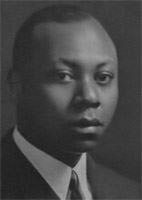 William Dabney Bowman was born in Houston in 1917, and raised in Youngstown Ohio. He attended the Massachusetts Institute of Technology, graduating in 1944, and joined NASA. In 1950, he left to join the heat transfer department at Ford. In 1953, he joined Ford's then-new program in aerodynamics, heading the department by the time of his retirement. After their deaths, Bowman and his wife Charlotte endowed MIT with a gift of $1 million to fund research in cancer, heart disease, and diabetes.
William Dabney Bowman was born in Houston in 1917, and raised in Youngstown Ohio. He attended the Massachusetts Institute of Technology, graduating in 1944, and joined NASA. In 1950, he left to join the heat transfer department at Ford. In 1953, he joined Ford's then-new program in aerodynamics, heading the department by the time of his retirement. After their deaths, Bowman and his wife Charlotte endowed MIT with a gift of $1 million to fund research in cancer, heart disease, and diabetes.
William Bowman lived at 2481 Longfellow beginning in the 1950s.
Read a profile of William D. Bowman in Ebony Magazine.
Carl Breer
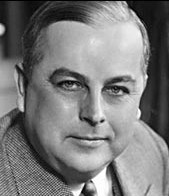
Carl Breer was born in Los Angeles in 1883; as a youngster, he worked in his father's blacksmith and carriage shop. When Frank Duryea exhibited his pioneering automobile on the west coast, it grabbed Breer's attention. By 1901, he had designed and built his own steam-powered automobile. He graduated from Stanford in 1909, and worked with a string of early automotive companies, including Tourist Automobile, Duro Car, Allis-Chalmers, and Moreland Motor Truck, where he was factory superintendent. After leaving Moreland, he established his own company, Acme Electrical Auto Work. In 1916, he joined Studebaker and established their research division. He moved to Willys in 1920, there joining Walter P. Chrysler.
He followed Chrysler to Maxwell Motor Car in 1923, and when Chrysler Corporation was formed in 1925, Breer headed their Engineering and Research department, a post he held until 1949. While there, Breer designed the legendary Chrysler Airflow, the first modern aerodynamic automobile; he also contributed to a number of Chrysler firsts, including aluminum pistons, bronze engine bushings, helical gear transmissions, and sealed-beam headlights.
Carl Breer lived at 2435 W. Boston Boulevard (later the home of David Wilkus and Junius Taylor) in the 1930s.
Read more about Carl Breer from the Automotive Hall of Fame, and read The birth of Chrysler Corporation and its engineering legacy, written by Carl Breer and Anthony J. Yanik.
Walter O. Briggs
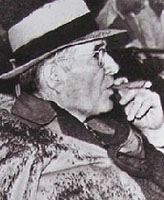
Walter O. Briggs was born in Ypsilanti in 1877 and worked for Everitt Carriage Works in the early 1900s, eventually buying the company and changing the name to Briggs Manufacturing in 1909. Briggs specialized in the making of automotive car bodies, supplying bodies to manufacturers such as Ford, Chrysler, Packard, Hudson, and Willys-Overland. After Fisher Body was purchased by General Motors, Briggs was the nation's largest producer of car and truck bodies. During the Depression, Briggs turned to other products, gradually expanding into plumbing products as market for car bodies shrank. Briggs owned the company until his death; the company survived until 1997 when it was purchased by a South American conglomerate.
In 1919, Briggs purchased stock in the Detroit Tigers from Frank Navin, becoming sole owner after Navin's death. Briggs owned the Tigers until his death in 1952. He expanded the Tiger's playing field to increase seating capacity, opening it in 1938 as Briggs Stadium.
In 1915, Briggs moved into Boston-Edison at 700 W. Boston Boulevard, where he lived until his death in 1952.
Read more about Briggs Manufacturing.
James Couzens
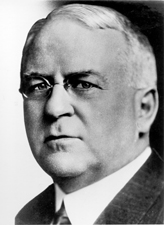
Born in Ontario, James Couzens moved to Detroit in 1890. In 1903, Couzens, was a clerk for coal dealer Alexander Y. Malcomson. Malcomson bankrolled a new company started by Henry Ford, and Couzens invested $2400 in the venture. Couzens became vice president and general manager of Ford Motor Company, and the company prospered in part because of his business acumen. In 1919, he sold his shares back to Ford for 35 million dollars.
Couzens held other important financial positions, as president of the Bank of Detroit and director of the Detroit Trust Company. During this time, he went into public service, first as street railway commissioner in 1913 and then police commissioner of Detroit in 1916. He was elected mayor in 1919, and served until appointed to the United States Senate in 1922. Couzens served in the Senate until his death in 1936.
Couzens also was a noted philanthropist, who established the Children's Fund of Michigan with a $10,000,000 grant, and gave $1,000,000 for relief in Detroit during the Depression.
James Couzens built a home at 610 Longfellow in Boston-Edison in 1910, where he lived until the late 1920s, after which it was inhabited by his son Frank.
Read James Couzens' Congressional biography, or his bio from the Automotive Hall of Fame, or a read a book about him.
William C. Cowling
 William Charlton Cowling was born in Oshkosh, Wisconsin in 1874. He attended the University of Minnesota, then Northwestern, and received a law degree. He served a term in the Wisconsin State Legislature beginning in 1902, and served as Oshkosh’s city attorney from 1905 to 1909, as well as serving on its city council. In 1914, Cowling moved to Detroit to open a freight-auditing bureau. There he met Henry Ford, and in 1915, Cowling joined the Ford Motor Company in the freight traffic office. He moved on to be executive head in charge of company affairs and in 1930, was promoted to General Sales Manager, directing both domestic and foreign sales.
William Charlton Cowling was born in Oshkosh, Wisconsin in 1874. He attended the University of Minnesota, then Northwestern, and received a law degree. He served a term in the Wisconsin State Legislature beginning in 1902, and served as Oshkosh’s city attorney from 1905 to 1909, as well as serving on its city council. In 1914, Cowling moved to Detroit to open a freight-auditing bureau. There he met Henry Ford, and in 1915, Cowling joined the Ford Motor Company in the freight traffic office. He moved on to be executive head in charge of company affairs and in 1930, was promoted to General Sales Manager, directing both domestic and foreign sales.
Cowling resigned from Ford in 1937, moving to Willys-Overland Motors, Inc. in Toledo to become vice-president. In 1939 he left Willys to purchase and run Automobile Topics, a trade magazine. He died in 1956 in Detroit.
William C. Cowling lived at 1646 W. Boston in the early 1920s.
Marvin E. Coyle
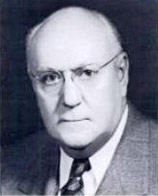
Marvin E. Coyle was an accountant, and began working at Chevrolet as a secretary at the birth of the company in 1911. He stayed with the company as it was folded into General Motors, eventually becoming an assistant to Chevrolet president William S. Knudsen. In 1929, he was appointed vice-president, and had a substantial hand in running the division. In 1933, Coyle was named general manager of Chevrolet and in 1937 a corporate vice-president and director of General Motors. Coyle guided Chevrolet through the Depression and the subsequent war years, and relinquished the lead of Chevrolet in 1945. Coyle retained the corporate vice-presidency until his retirement at the beginning of 1951.
Marvin E. Coyle lived at 1411 Edison in the mid-1920s.
Burt J. Craig
 Burt John Craig was born in Detroit in 1885. After schooling, he went to work as a bookkeeper, and in 1907 joined Ford Motor Company. When Edsel Ford became treasurer of the company in 1918, Craig was made assistant treasurer. In 1925, he became the controller for the company, and also acted as assistant treasurer for some of Ford's subsidiaries, notable Lincoln Motor Car and the Stout Metal Airplane Company. As the Great Depression broke, Craig was instrumental in marshaling Ford's resources to stabilize local banks and the city of Detroit.
Burt John Craig was born in Detroit in 1885. After schooling, he went to work as a bookkeeper, and in 1907 joined Ford Motor Company. When Edsel Ford became treasurer of the company in 1918, Craig was made assistant treasurer. In 1925, he became the controller for the company, and also acted as assistant treasurer for some of Ford's subsidiaries, notable Lincoln Motor Car and the Stout Metal Airplane Company. As the Great Depression broke, Craig was instrumental in marshaling Ford's resources to stabilize local banks and the city of Detroit.
In 1939, Craig helped found the Ford Foundation, and became one of its first directors. After Edsel Ford's death in 1943, Craig joined the board of Ford Motor Company as vice president and treasurer. He left the company in 1946 to work full time at the Ford Foundation, where he stayed until his retirement in 1951. Burt Craig died in 1954.
Burt J. Craig lived at 2314 W. Boston in the 1920s.
Ed Davis

Edward Davis was born in Shreveport, Louisiana in 1911, and as a youngster fell in love with cars. At the age of fifteen, Davis convinced his father to allow him to move to Detroit, where he attended Cass Technical High School. He worked a series of jobs that allowed him to learn more about the automobile business. In 1936, Ed Davis began his first car salesman job at the Merton L. Lampkins Chrysler-Plymouth dealership in Highland Park, where he established a growing clientele of loyal customers. In 1938 he struck out on his own, opening up Davis Motor Sales as a used car lot in Paradise Valley. In 1940 he opened a Studebaker dealership, running it until 1956. In 1963, Ed Davis secured a new-car franchise with Chrysler-Plymouth — making him the first African-American to be awarded a "Big Three" auto franchise.
Ed Davis retired from his dealership in 1971, but served as general manager of the Department of Street Railways from 1971 to 1974. He passed away in 1999.
Ed Davis lived at 2020 West Chicago beginning in the early 1950s.
Read a biography of Ed Davis, or his entry in the Automotive Hall of Fame, or read his auto-biography.
Harry G. Diefendorf
Harry Goodrich Diefendorf was born in Erie, Pennsylvania in 1879. He attended Penn; after graduation he worked for a Philedelphia newspaper in 1901-02, dabbled in real estate, and managed the Bay State Machine Company in Erie. In 1908, he became the New York agent for the Gray Motor Company of Detroit, then a manufacturer of marine engines. In 1910, he came to Detroit as general manager and treasurer of the Gray Motor Company, and in 1912 wrote the book. "The Gasoline Engine: Marine and Stationary." In 1918, Diefendorf became general manager of Recording Devices Company, a gearmaker. In 1923 he purchased the automotive steering gear division of Recording Devices and moved it to Detroit, renaming the company CPC Products.
Harry G. Diefendorf lived at 874 Edison in the mid-1910s.
John W. Drake
 The Hupp Motor Car Co. was organized in 1908 with four partners; three (including Drake) providing funds and the fourth, founder Robert Hupp, providing engineering expertise. Drake was named president. Sales of Hupmobiles were instantly successful, and the company built 5000 cars in 1910.
The Hupp Motor Car Co. was organized in 1908 with four partners; three (including Drake) providing funds and the fourth, founder Robert Hupp, providing engineering expertise. Drake was named president. Sales of Hupmobiles were instantly successful, and the company built 5000 cars in 1910.
In 1911, Robert Hupp left the company, but sales climbed, with 24,000 cars sold in 1920 and 65,000 in 1928. However, the Depression hit the company hard, and a corporate takeover that removed Drake from control of the company ensured its downfall. Although Drake regained control of Hupp later, the company never recovered, and finally folded in 1940.
Drake moved to Boston-Edison in 1911, building a home at 650 W. Boston, where he lived until selling to C. Harold Wills.
Read more about Hupmobile from Hemmings.
Alfred O. Dunk
Alfred Dunk was born in 1873 in Saginaw, Michigan. He spent some time in the employ of family businesses before striking out on his own. In 1896 he founded the A. O. Dunk Co. in New York; in 1902 he moved to Detroit to found the Puritan Machine Co, which manufactured engines, transmissions, and other mechanical components. In 1908, he set up the Auto Parts Manufacturing Co at the request of Walter Flanders, when the latter had formed E-M-F (with William Metzger). Alfred Dunk went on to own or head numerous automotive-related companies.
In 1929, after the stock market crash, the Detroit Electric Car company filed for bankruptcy. Alfred Dunk, who specialized in reorganizing failing businesses, purchased the company and reorganized it into the Detroit Electric Vehicle Manufacturing Co. The company kept producing electric cars until after Dunk's death in 1936, eventually folding in 1938.
Dunk lived at 631 Chicago Boulevard in the 1910s.
Read more about Detroit Electric Car.

Margaret T. Fisher
Margaret Theisen was born in 1857 in Baden, Germany. She emigrated to the United States and settled in Ohio, where, in 1876, she married Lawrence P. Fisher. The couple had eleven children; their seven sons -- Frederick J., Charles T., Lawrence P., William A., Edward F., Alfred J., and Howard A. Fisher -- together built Fisher Body Corporation.
Four of the Fisher Brothers lived in Boston-Edison, together with Margaret T. Fisher, who lived at 101 Longfellow in the 1920s, after her husband passed away.
Alfred J. Fisher
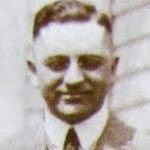 Alfred Fisher was born in 1892 in Norwalk, Ohio. Alfred's history is tied to Fisher Body and his brother Charles. In 1913, both Alfred and Edward Fisher graduated from the Andrew F. Johnson Carriage and Automobile Drafting School in New York, and joined their brothers Charles, Fred, and Lawrence at the thriving Fisher Body company. Alfred eventually became a vice-president Fisher Body and the director of its aircraft division.
Alfred Fisher was born in 1892 in Norwalk, Ohio. Alfred's history is tied to Fisher Body and his brother Charles. In 1913, both Alfred and Edward Fisher graduated from the Andrew F. Johnson Carriage and Automobile Drafting School in New York, and joined their brothers Charles, Fred, and Lawrence at the thriving Fisher Body company. Alfred eventually became a vice-president Fisher Body and the director of its aircraft division.
Alfred built and lived in a home at 1556 Chicago in the early 1920s, when both Charles and Edward were also moving into Boston-Edison.
Read Alfred J. Fisher's bio from the Automotive Hall of Fame.
Charles T. Fisher
 Charles Thomas Fisher was born in 1880 in Norwalk, Ohio. Around the turn of the century, Fisher moved to Detroit and began work at a carriage body manufacturer. In 1908, Fisher, along with his brother Fred and uncle Albert, founded the Fisher Body Company, making bodies for the emerging automobile industry. Charles and Fred soon brought their five younger brothers (including Alfred, Edward and William) into the business. The firm quickly prospered, producing bodies for many different manufacturers, including Cadillac, Ford, and Studebaker. By 1914 they were making 370,000 car bodies a year.
Charles Thomas Fisher was born in 1880 in Norwalk, Ohio. Around the turn of the century, Fisher moved to Detroit and began work at a carriage body manufacturer. In 1908, Fisher, along with his brother Fred and uncle Albert, founded the Fisher Body Company, making bodies for the emerging automobile industry. Charles and Fred soon brought their five younger brothers (including Alfred, Edward and William) into the business. The firm quickly prospered, producing bodies for many different manufacturers, including Cadillac, Ford, and Studebaker. By 1914 they were making 370,000 car bodies a year.
In 1919, Ford, General Motors, and Studebaker competed to buy Fisher Body. GM won out, purchasing 60% of the business to for 27 million dollars. In 1926, the Fishers sold their remaining shares for 208 million dollars, making Fisher Body wholly owned by GM. Charles became a vice-president of GM, leaving in 1934. The next year, the Fisher brothers began building the magnificent Fisher Building, one of the best examples of Art Deco architecture in the country, on Grand Boulevard a mile south of Boston-Edison.
In 1922, Fisher built a home at 670 W. Boston, where he lived until his death in 1963.
Read Charles T. Fisher's bio from the Automotive Hall of Fame and a short history of Fisher Body, as well as profiles in Time Magazine of Fisher Body and the Fisher Brothers (twice).
Edward F. Fisher
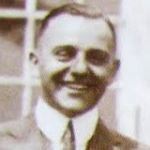 Edward Fisher was born in 1891 in Norwalk, Ohio. Edward, with his brother Alfred, graduated from the Andrew F. Johnson Carriage and Automobile Drafting School in 1913, and joined their brothers Charles, Fred, and Lawrence at the Fisher Body company. Edward eventually became a vice-president and director of GM and general manager of GM's Fisher Body division after Fisher Body was sold to that company.
Edward Fisher was born in 1891 in Norwalk, Ohio. Edward, with his brother Alfred, graduated from the Andrew F. Johnson Carriage and Automobile Drafting School in 1913, and joined their brothers Charles, Fred, and Lawrence at the Fisher Body company. Edward eventually became a vice-president and director of GM and general manager of GM's Fisher Body division after Fisher Body was sold to that company.
Edward built a home at 892 W. Boston (designed by Richard Marr) in 1923, just a year after his brother Charles built his home; Edward lived there until the mid-1950s.
Read Edward F. Fisher's bio from the Automotive Hall of Fame.
William A. Fisher
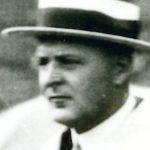 William Fisher was born in 1886 in Norwalk, Ohio. William was the last of the Fisher brothers to join Charles at Fisher Body, arriving in 1915. He was involved in the operation of Hinkley Motors (founded by Carl C. Hinkley) in the late 1910s and 1920s. William eventually became president of the Fisher Body division after the family company was sold to General Motors.
William Fisher was born in 1886 in Norwalk, Ohio. William was the last of the Fisher brothers to join Charles at Fisher Body, arriving in 1915. He was involved in the operation of Hinkley Motors (founded by Carl C. Hinkley) in the late 1910s and 1920s. William eventually became president of the Fisher Body division after the family company was sold to General Motors.
In 1916, William Fisher built a house in Boston-Edison at 111 Edison Avenue, where he lived until the late 1920s.
Read William A. Fisher's bio from the Automotive Hall of Fame.
Carl H. L. Flintermann
Carl H. L. Flintermann was born in Detroit in 1876. As a young man, he worked in a hardware store and a bank before moving on to manufacturing. In 1913, he was elected managing vice-president of the Detroit Pressed Steed Company, where he was in charge of promoting the company's steel automotive wheels. In 1923, he organized and became president of Flintlock Corporation, a manufacturer of automotive radiators, and in 1928 he became president of the Wilcox-Rich Corporation, and automotive supplier. He was also a director of the Denby Motor Truck Company, and in 1927 led the reorganization of Divco (maker of the iconic milk truck), becoming chairman of the reorganized company, Divco-Detroit. Flintermann died an untimely death in 1931.
Carl H. L. Flintermann lived at 1232 W. Boston in the 1920s.
Henry Ford

Henry Ford's story is well-known. In 1903, with the help of a handful of investors (including James Couzens and Horace Rackham), Ford incorporated Ford Motor Company. The company introduced the Model T in 1908. The car was wildly popular, and sales grew to 250,000 by 1914; by 1918, half of all cars in America were Model Ts.
Ford Motor Company developed a number of innovations in car production, most notably the moving assembly line, introduced in 1913. Sales continued to increase, and in 1919, Henry and his son Edsel bought all outstanding stock in the company, giving them sole ownership.
Henry Ford was also a philanthropist, building Henry Ford Hospital (located a mile south of Boston-Edison on Grand Boulevard) in 1915 and leaving a substantial portion of his fortune to the charitable Ford Foundation upon his death in 1947.
In 1908, Henry Ford moved into a new home in Boston-Edison at 140 Edison. Henry lived in the house until moving to Fairlane in Dearborn, his last home.
Read Ford's biography from the Automotive Hall of Fame, a profile in Time Magazine, visit the Piquette plant where Model Ts were made, or go to the Henry Ford for more information.
Joseph A. Galamb
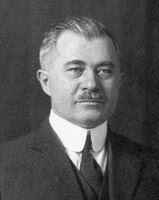 Joseph Galamb was born in 1881 in what is now Hungary. He received a diploma in mechanical engineering in 1899 and went to work for the Hungarian Automobile Company. He soon moved on, spending time assembling engines in Germany, then traveling to America for the 1904 World's Fair. Although he originally planned to return to Germany, Galamb wound up staying in the United States, finding work in Pittsburgh and Cleveland before joining the Ford Motor Company as a designer in 1905.
Joseph Galamb was born in 1881 in what is now Hungary. He received a diploma in mechanical engineering in 1899 and went to work for the Hungarian Automobile Company. He soon moved on, spending time assembling engines in Germany, then traveling to America for the 1904 World's Fair. Although he originally planned to return to Germany, Galamb wound up staying in the United States, finding work in Pittsburgh and Cleveland before joining the Ford Motor Company as a designer in 1905.
Galamb soon became the lead designer for the company, and was instrumental in designing the Model T, as well as subsequent Ford products, including the Fordson tractor, Liberty aircraft engines, and the 1927 Model A. He officially received the title of Chief Designer in 1937. Galamb continued to work at Ford, designing a small car during World War II, until he retired for health reasons in 1944. He died in 1955.
Joseph A. Galamb lived at 2044 Edison in the 1920s.
Read Galamb's biography from Wikipedia or from Hemmings Motor News.
Charles A. Grant
Charles Grant was born in 1879 in Canada; his family moved to Detroit in 1887. After completing school, he went into sales and business, including a two-year stint with Ford Motor Company as an assistant to James Couzens. In 1898, Grant and his brother George started a retail automotive business where they sold Buick, Chalmers, and Thomas cars. In 1910, the brothers changed track and started the Grant Brothers Foundry Company, where Charles was the treasurer. In 1913, the brothers founded the Grant Motor Car Company, with a factory in Findlay, Ohio. The company built small, maneuverable roadsters, first in the Findlay plant, and later in Cleveland. The company closed in 1922. In 1916, George and Charles added another business: Grant & Marx Brass Works, where Charles was also treasurer. During World War I, the businesses made airplane parts and artillery shells.
Charles A. Grant lived at 2020 Longfellow in the late 1920s and early 1930s.
Philip H. Gray
 Philip H. Gray was born in 1865 in Detroit, the son if candy-maker and financier John S. Gray. More significantly, in 1903, John S. Gray invested in and became first president of Ford Motor Company, remaining president until his death in 1906. Although Philip Gray was not involved in running Ford, he and his three siblings inherited their father's stock. Dividends and eventual sale of the stock netted the Gray family over $36 million.
Philip H. Gray was born in 1865 in Detroit, the son if candy-maker and financier John S. Gray. More significantly, in 1903, John S. Gray invested in and became first president of Ford Motor Company, remaining president until his death in 1906. Although Philip Gray was not involved in running Ford, he and his three siblings inherited their father's stock. Dividends and eventual sale of the stock netted the Gray family over $36 million.
After attending school in Detroit, Philip Gray joined his father's candy-making firm. After gaining experience there, he opened a successful life insurance firm. He worked there until shortly after his father's death. Recognizing the scale of his inheritance, Gray devoted the remainder of his life to philanthropy, saying that he was only a trustee of the great fund, and that it was his duty to dispense it wisely. He was was president of the Detroit Y.M.C.A. and donated heavily to the organization, including the founding of Camp Nissokone in Oscoda. He also helped found the Detroit Symphony Orchestra and Orchestra Hall, and donated funs to build the Central Christian Church and the Detroit Osteopathic Hospital.
Philip H. Gray lived at 658 Longfellow from the late 1910s until his death in 1922. His wife Almeda S. Gray remained living in the house until 1937.
Ira L. Grinnell
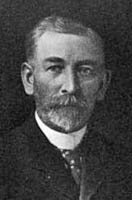
Ira Grinnell was born in New York in 1848. In 1866, he moved to Manchester, Michigan, and in 1867 began work in the sewing machine business in Ann Arbor. In 1880, Grinnell and his brother Clayton opened a music firm in Ann Arbor, and two years later moved to Detroit. In 1901, the firm began manufacturing pianos, a move that met with immediate success. In 1908 the firm built a headquarters on Woodward Avenue and in 1913, they opened a manufacturing plant in Holly, touted as "the largest piano factory on the earth." The Grinnell Electric Auto Co. built electric automobiles in Detroit from 1912 - 1915.
Ira L. Grinnell lived at 650 W. Boston Boulevard, the home originally built for John W. Drake, for a short while until his death in the early 1920s.
Read an article on Grinnell's pianos in the Detroit News.
Richard Harfst
Richard Harfst was born in Detroit in 1882. He joined the State Savings Bank, becoming a branch manager. In 1912, he became secretary to William C. Leland, who in 1917 was one of the founders of the Lincoln Motor Car Company. In 1920, he moved to General Motors, where he was secretary to Karl Zimmerschied, the president of Chevrolet. In 1921, he became head of the Detroit-area sales for Cadillac, then purchased a state-wide franchise for Huppmobile. In 1927, he became general manager of the Detroit Auto Club. He held that position for nearly 25 years, until his death in 1951.
Richard Harfst lived at 1683 Longfellow from the early 1920s through his death in 1951.
Fred E. Holmes

Frederick Elias Holmes was born in Port Huron on November 4, 1872, the first child of Almon and Sarah (Adams) Holmes. In his boyhood he worked for Thomas Edison as a payroll bicycle courier between Port Huron and Detroit. In 1907, he started the Fred E. Holmes Company, an early supplier of materials and parts to the automobile industry, particularly seat cushions. Holmes was also a director of the Detroit Motor Appliance Company and the Federal Discount Corporation of Detroit, and part owner of the Washington Theatre Company and the Orpheum Theatre Company. In October, 1915, Holmes married Mabel Agnes Carroll of Logansport, Indiana. They had one child, Jean Carroll, born 1919. Fred Holmes died in 1966.
Fred and Mabel Holmes moved into the Boston-Edison neighborhood, at 960 Chicago, and lived there until the early 1930s.
John H. Hunt
 John Herman Hunt was born in Saranac Michigan in 1882. He graduated University of Michigan in 1905 with an Electrical engineering degree. He worked at Western Electric and the Ohio State University before joining Packard Motor Car Company in 1912. In 1920 he became head of the electrical division of General Motors Research Corp, then became head of electrical for GM Research Laboratories in 1925. in 1935 he was named director of the New Devices Section of General Motors, evaluating thousands of ideas submitted to the Corporation by outside inventors and supplier industries. Hunt served as the president of the Society of Automotive Engineers in 1936-38, and retired from General Motors in 1949.
John Herman Hunt was born in Saranac Michigan in 1882. He graduated University of Michigan in 1905 with an Electrical engineering degree. He worked at Western Electric and the Ohio State University before joining Packard Motor Car Company in 1912. In 1920 he became head of the electrical division of General Motors Research Corp, then became head of electrical for GM Research Laboratories in 1925. in 1935 he was named director of the New Devices Section of General Motors, evaluating thousands of ideas submitted to the Corporation by outside inventors and supplier industries. Hunt served as the president of the Society of Automotive Engineers in 1936-38, and retired from General Motors in 1949.
John Herman Hunt lived at 1444 Edison (previously owned by William T. Nash) in the 1930s and 1940s.
Benjamin A. Jeffery
In 1906, Benjamin A. Jeffery and his brother Joseph (a dentist) filed for a spark-plug patent, based primarily on Joseph's knowledge of porcelain. With that, they started the Reliance Automobile Co. in San Francisco, and, in 1908, the Jeffery-Dewitt Co. in Newark, NJ to make spark plugs. In 1910, the firm moved to Detroit. There, the business rapidly expanded as orders for porcelain insulators exceeded the brothers' expectations. In 1915, Champion Spark Plug Co. assumed responsibility for manufacturing the Jeffery-Dewitt brand, and in 1921 bought the Jeffery-Dewitt Company outright. Jeffrey continued as a vice president of the firm.
Benjamin Jeffery lived at 741 Edison in the late 1920s and early 1930s.
Henry B. Joy

Henry Bourne Joy was born in Detroit in 1864; his father was president of the Michigan Central Railroad and a close friend of Abraham Lincoln. Henry graduated from Yale in 1892 and married Helen Newberry, sister of his lifelong friend Truman Newberry. He spent some time in mining in Utah, and then began working in companies associated with his father. He worked for the Peninsular Car Co, becoming assistant treasurer. He was then treasurer of the Fort Street Union Depot, and, upon his father's death in 1898, president of the Detroit Union Depot and Station Co. During the Spanish-American War, Joy served aboard the USS Yosemite with Newberry.
In 1902, Joy bought a car from James Packard. Impressed with the design, he convinced a group of investors, including his brother-in-law Truman Newberry, to invest in the automobile company. The group put up $250,000 and organized the Packard Motor Car company with Packard as president and Joy as general manager. Joy oversaw a steady expansion of Packard, with increasing production and sales. Eventually he became chairman of the board in 1916. In 1918, he stepped down to accept a commission as Colonel in the US Army, but resumed his position at Packard when WWI ended. He served as chairman until 1926.
In 1915, Henry Joy platted out the Joy Farms subdivision, stretching from 14th Street (now Rosa Parks) to Linwood, encompassing the western third of the Boston-Edison neighborhood.
Read Joy's bio from the Automotive Hall of Fame.
Peter E. Martin
 In 1903, C. Harold Wills hired Peter Martin to work at Ford Motor Company; Martin was the fifth Ford employee hired. Martin was plant superintendent first at the Piquette Plant and then at the Rouge facility, and in 1924 was named Vice-President of Manufacturing. Martin was a trusted advisor to Henry Ford; it was reported in 1939 that Martin was one of only three directors of the company, the other two being Henry and Edsel Ford. Martin resigned from Ford in 1940 due to ill health.
In 1903, C. Harold Wills hired Peter Martin to work at Ford Motor Company; Martin was the fifth Ford employee hired. Martin was plant superintendent first at the Piquette Plant and then at the Rouge facility, and in 1924 was named Vice-President of Manufacturing. Martin was a trusted advisor to Henry Ford; it was reported in 1939 that Martin was one of only three directors of the company, the other two being Henry and Edsel Ford. Martin resigned from Ford in 1940 due to ill health.
Peter E. Martin lived at 1486 Chicago Boulevard during the 1920s.
William E. Metzger

William Metzger was born in Peru, IL, in 1868 and at the age of 10 moved to Detroit with his father. As a young man, Metzger became enamored of bicycle riding, and soon joined Stanley B Huber to open Huber & Metzger, a bicycle shop located in the center of downtown Detroit. The store soon became one of the largest in the country, and dealt directly with suppliers in England. In 1895, Metzger attended the world's first automobile show in London. He returned to Detroit convinced of the automobile's future, and built the first U. S. automobile retail showroom, which opened in 1897. Metzger sold electric, steam, and gasoline brands, including automobiles built by Oldsmobile; in June 1899, Metzger sold the first automobile built by the company. In 1899, Metzger helped organize the Detroit Auto Show, only the second of its kind. He also promoted racing, putting up the $200 prize won by Barney Oldfield driving the Ford 999 -- a win that had a substantial impact on Henry Ford's fortunes.
In 1900, Metzger organized the Northern Motor Car Co. Two years later, Metzger was one of the people who organized the Cadillac Motor Car Co. In 1903, with only three cars produced, Metzger took orders for 2700 Cadillacs at the New York Auto Show, ensuring the company's fortunes. Metzger stayed with Cadillac as sales manager until 1908, when Northern merged with Wayne Automobile Company (controlled by Byron Everitt and Walter Flanders) to form the E-M-F (Everitt-Metzger-Flanders) Company. The company arranged for Studebaker to market their cars. In 1909, EMF-Studebaker produced almost 8000 cars, making it the fifth largest auto maker in the US. However, although E-M-F was growing (it would produce 26,000 automobiles in 1911, second only to Ford), Metzger was unhappy with the partnership with Studebaker. In mid-1909, Metzger left the company, taking Byron Everitt and a $362,500 settlement with him.
With the money, Metzger and Everitt began the Metzger Motor Car Co, producing a car (called the Everitt) that was substantially similar to E-M-F's model. Metzger again used his sales skills, and the first year's production of 2500 Everitts were pre-sold before the first one rolled off the assembly line. Flanders soon bolted E-M-F to join them, but the unsettled finances of the new company proved its downfall. Luckily for Metzger, Flanders financially juggled the company, selling it to the United States Motor Co. Metzger took his profits from the sale and left. After the dissolution of Flanders, Metzger became affiliated with numerous other automotive companies, including Columbia Motor Car, Wills Sainte Claire, Federal Motor Truck Co., Rickenbacker, and the Auto Parts Manufacturing Co. (where he took over as president from Alfred Dunk). He also was appointed to the executive committee of the American Automobile Association, and was elected president of the Detroit Board of Fire Commissioners.
William Ernest Metzger built a house at 56 Longfellow, one of the very first built in Boston-Edison. He lived there until his death in 1933.
Read Metzger's bio from the Automotive Hall of Fame, read more about the history of E-M-F, or read a book about it.
William T. Nash
William T. Nash was born in Windsor April 4 1873. In 1903, he joined the newly-formed Cadillac Motor Car Co. as auditor and Comptroller. He remained with the company until 1917, when Henry and Wilfred Leland left Cadillac to form a new company: Lincoln. Nash was elected secretary-treasurer of Lincoln (the Lelands were president and vice-president). Nash remained in that position until 1922, when Lincoln went into receivership (eventually being purchased by Henry Ford). Nash moved on to become secretary and general manager of the Monarch Bumper Manufacturing Company and was also treasurer of the Atlas Foundry Company, unexpectedly passing away in 1924.
William T. Nash lived at 1444 Edison (later owned by John H. Hunt) in the early 1920s, until his death.
Truman Newberry
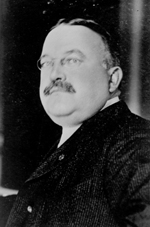
Truman Newberry was born in 1864 in Detroit, the son of a wealthy businessman. He worked at a number of business ventures, working his way up to the position of manager of the Detroit, Bay City & Alpena Railway, and becoming president and treasurer of the Detroit Steel & Spring Company, along the way shrewdly investing his fortune to become a multi-millionaire
In the late 1890s, Newberry served with the US Navy, including as a lieutenant on the USS Yosemite (with lifelong friend and brother-in-law Henry Joy) during the Spanish-American War. He served as Assistant Secretary of the Navy from 1905-1908, and as Secretary of the Navy in 1908 and 1909. In 1919, he was elected to the United States Senate in a fierce contest with Henry Ford. There were some irregularities in the election, and Newberry wasn't seated in the Senate for some time. As a result, Newberry resigned in 1922.
In 1902, Henry Joy, Newberry's brother-in-law, bought a car from James Packard. Impressed with the design, he convinced a group of investors, including Newberry, to invest in the automobile company. The group put up $250,000 and organized the Packard Motor Car company.
In 1913, Truman Newberry and his brother John platted out the Boston Boulevard subdivision, stretching from Hamilton to 14th Street (now Rosa Parks), encompassing the middle third of the Boston-Edison neighborhood.
Read Truman Newberry's Congressional biography.
Meyer L. Prentis

Meyer L. Prentis was born in Kovno, Lithuania in 1886; his family moved to St. Louis when he was two. Prentis studied accounting in St. Louis and moved to Detroit in 1911 at the age of 25 to work for General Motors. He was the chief accountant and auditor for GM, and in 1916 was promoted to comptroller. Three years later, Prentis became treasurer of General Motors, a position he held until 1951.
Prentis was also known for his philanthropy. He was a founder and the first secretary-treasurer of the United Foundation of Greater Detroit (now the United Way for Southeastern Michigan). He endowed the Meyer L. Prentis Cancer Center at the Detroit Medical Center. The Meyer and Anna Prentis Building now houses the School of Business Administration on Wayne State University's campus.
In 1925, Meyer L. Prentis built a home at 664 Chicago Boulevard, where he lived until the early 1930s.
Martin L. Pulcher
Martin L. Pulcher was born in Pontiac in 1877. After completing school, he worked in a buggy factory in Pontiac for eight years. In 1907, Pulcher helped organize the Oakland Motor Car Company in Pontiac, Michigan, and served an secretary-treasurer. Sales of the Oakland were immediately successful, and Oakland attracted the attention of William Durant, head of the newly-formed General Motors. By 1909, GM completely acquired Oakland, and Pulcher left the company the next year. (Oakland continued to sell well until it was supplanted by the Pontiac nameplate in the early 1930s.) In 1910, Pulcher founded Bailey Motor Truck, quickly changing the name to Federal Motor Truck. The firm produced around 160,000 heavy trucks during its operation from 1910 to 1959.
Martin L. Pulcher lived at 101 Chicago Boulevard in the 1920s and 1930s, which was later occupied by Helene Rother.
Read a book about Federal Motor Truck.
Horace Rackham
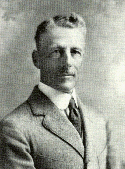
Horace Rackham was a Detroit lawyer who opened his own law office in 1894. In 1903, Henry Ford engaged Rackham to draw up documents incorporating the Ford Motor Company. Sensing an opportunity, Rackham borrowed $5000 and bought 50 shares in the new company. Ford Motor company was, of course, wildly successful, and in 1907 Rackham built a new home at 90 Edison in Boston-Edison, and in 1913 quit his law practice. In 1919, Ford bought back Rackham's shares for 12.5 million dollars.
Horace Rackham and his wife Mary devoted the rest of their lives to philanthropy. In addition to supporting numerous charities, Rackham gave extensively to the University of Michigan, underwriting expeditions and fellowships. He also left the university $100,000 for graduate student loans. The University named its graduate college, as well as the building housing it, after Horace H. Rackham.
The results of Rackham's philanthropy can also be seen in and around the city of Detroit. Most significantly, in 1924, Rackham gave property in Huntington Woods to the city of Detroit. Some of this property was used as parking for the new Zoo (a memorial fountain at the zoo bears Rackham's name); the remainder was used to build a public golf course, now known as the Rackham Golf Course. Within the city, the Horace H. Rackham Education Memorial Building, built in 1941, stands at Farnsworth and Woodward in Detroit's cultural district.
Horace Rackham lived at 90 Edison until his death in 1933.
Read more about Horace Rackham from the University of Michigan's Graduate school.
Helene Rother
 Helene Rother was born in Germany in 1908, and later moved to Paris, where she designed jewelry. When the Nazis invaded France at the beginning of World War II, Rother fled to Casablanca with her then-seven-year-old daughter, living for months in a refugee camp. She eventually made her way to New York City in 1941. She first worked for Marvel Comics, then in 1942 moved to Detroit to work for Harley Earl at General Motors, as an interior designer. She was one of the first woman to have such a position.
Helene Rother was born in Germany in 1908, and later moved to Paris, where she designed jewelry. When the Nazis invaded France at the beginning of World War II, Rother fled to Casablanca with her then-seven-year-old daughter, living for months in a refugee camp. She eventually made her way to New York City in 1941. She first worked for Marvel Comics, then in 1942 moved to Detroit to work for Harley Earl at General Motors, as an interior designer. She was one of the first woman to have such a position.
In 1947, she opened her own design studio in the Fisher Building, specializing in automotive interiors, furniture, and stained glass. She was contracted by Nash Automobiles, and designed their interiors from 1948 to 1956, helping the brand reinvent itself as stylish and modern. Her interiors won the prestigious Jackson Medal for outstanding degsign in 1953. In the early 1950s, Rother purchased a home in Boston-Edison to use as a home and studio. She continued in automotive design, and designed stained glass for several area churches. She also designed sterling flatware. Helene Rother died in 1999.
Helene Rother lived at 101 Chicago Boulevard beginning in the 1950s, in the house formerly occupied by Martin Pulcher.
Read a biography of Helene Rothman, and her Wikipedia entry.
Adam H. Sarver
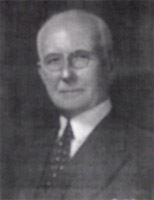 Adam Sarver was born in Pennsylvania in 1866. He became a travelling salesman, and in 1888 he went into business handling local sales for the Durant-Dort Buggy Company. When W. C. Durant began manufacturing automobiles, Sarver began selling them. In 1916, Durant's Chevrolet Company took control of Scripps-Booth Motor Company, and in 1917 Sarver was named president of Scripps-Booth. The following year, Chevrolet, along with Scripps-Booth, merged into General Motors, and Sarver moved to Detroit.
Adam Sarver was born in Pennsylvania in 1866. He became a travelling salesman, and in 1888 he went into business handling local sales for the Durant-Dort Buggy Company. When W. C. Durant began manufacturing automobiles, Sarver began selling them. In 1916, Durant's Chevrolet Company took control of Scripps-Booth Motor Company, and in 1917 Sarver was named president of Scripps-Booth. The following year, Chevrolet, along with Scripps-Booth, merged into General Motors, and Sarver moved to Detroit.
He continued as president of Scripps-Booth until the division was dissolved in 1922. In 1924, Sarver became president and director of the Durant Motor Co. He retired in 1930, and eventually moved to Florida, where he died in 1960.
In 1919, Sarver moved into a home at 655 Chicago Boulevard, where he lived until the early 1930s.
Read a Powerpoint presentation on the life of Adam Sarver.
Ernest W. Seaholm
 Ernest W. Seaholm was born in Sweden, but came to the United States as an infant in 1889. He grew up in Connecticut, and graduated from a mechanical arts high school in Massachusetts in 1905. After graduation, he worked as a draftsman, then joined Cadillac in 1913 as a transmission engineer. Seaholm was named the chief engineer at Cadillac in 1921, and remained in that position until he retired in 1943.
Ernest W. Seaholm was born in Sweden, but came to the United States as an infant in 1889. He grew up in Connecticut, and graduated from a mechanical arts high school in Massachusetts in 1905. After graduation, he worked as a draftsman, then joined Cadillac in 1913 as a transmission engineer. Seaholm was named the chief engineer at Cadillac in 1921, and remained in that position until he retired in 1943.
Ernest W. Seaholm lived at 1485 Edison in the 1920s.
Claude Sintz
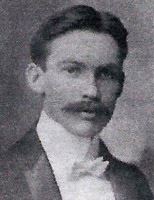 Claude Sintz was born in 1876, the son of inventor and machinist Clark Sintz. The elder Sintz began producing one of the earliest gasoline engines in Springfield, Ohio, in 1886. By 1894, the Sintz Gas Engine Company had moved to Grand Rapids, and in 1895 Clark and his sons Guy and Claude Sintz had started a new firm, Wolverine Motor Company, based on an engine design patented by Claude Sintz.
Claude Sintz was born in 1876, the son of inventor and machinist Clark Sintz. The elder Sintz began producing one of the earliest gasoline engines in Springfield, Ohio, in 1886. By 1894, the Sintz Gas Engine Company had moved to Grand Rapids, and in 1895 Clark and his sons Guy and Claude Sintz had started a new firm, Wolverine Motor Company, based on an engine design patented by Claude Sintz.
In 1902, Claude Sintz started Claude Sintz, Inc. in Detroit to manufacture automobiles, with the help of his brother and father. The foray into automobiles lasted only a few years, and Claude went on to found his own marine engine firm in Grand Rapids. He later manufactured farm equipment, and he had several patents in that area. In 1912, he formed his own firm, the Claude Sintz Company, to make specialty automotive parts. The Claude Sintz Company in existence into the 21st century.
Claude Sintz lived at 924 Edison from the 1910s until his death in 1956.
John H. Thompson

John H. Thompson was born in 1883 in Detroit. He started as a travelling salesman, then moved to New York City to work as a broker. He pursued a similar line of work in Chicago, then returned to Detroit in 1904 to work as a mechanic in the Cadillac and the Oldsmobile factories. He then brokered automobile parts for three years, and in 1909 organized the Thompson Auto Company, which distributed Federal Trucks (manufactured by Martin L. Pulcher). In 1912 he took two of his brothers into the business, remaining president. In 1918 he began distributing Maxwell and Chalmers automobiles. In the same year, he also organized the Thompson Airplane Company, which distributed Curtiss airplanes.
John H. Thompson lived at 1210 W. Boston Boulevard from 1920 through the late 1950s.
Sidney D. Waldon
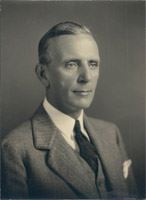 Sidney Waldon was born in 1873, and was one of the first people involved with Packard Motor Co, serving as vice-president and general manager. During WWI, Waldon was a Colonel involved in preparation of aircraft manufacturing for the war effort, and was instrumental in creating a viable US air force. Waldon was also director of engineering for Cadillac Motor Car Co. In 1924, James Couzens, then mayor, appointed Waldon to the Detroit Rapid Transit Commission. The commission developed a plan for a system of superhighways and rapid transit, which Waldon advocated for the rest of his life. Colonel Waldon lived in Boston-Edison in the 1910s and 1920s. However, he desired a quieter life in the country, and purchased a country estate near Clarkston, dubbing it Pine Knob. Sidney Waldron died in 1945.
Sidney Waldon was born in 1873, and was one of the first people involved with Packard Motor Co, serving as vice-president and general manager. During WWI, Waldon was a Colonel involved in preparation of aircraft manufacturing for the war effort, and was instrumental in creating a viable US air force. Waldon was also director of engineering for Cadillac Motor Car Co. In 1924, James Couzens, then mayor, appointed Waldon to the Detroit Rapid Transit Commission. The commission developed a plan for a system of superhighways and rapid transit, which Waldon advocated for the rest of his life. Colonel Waldon lived in Boston-Edison in the 1910s and 1920s. However, he desired a quieter life in the country, and purchased a country estate near Clarkston, dubbing it Pine Knob. Sidney Waldron died in 1945.
Colonel Waldon lived at 160 Longfellow in the 1910s and 1920s.
Read about the history of Pine Knob.
Albert M. Wibel
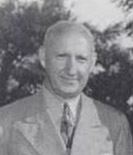 Albert Wibel was born in 1886 in Peru, Indiana. As an adult, he took up teaching as a career, and completer a course of study on the University of Indiana. However, in 1912, a friend purchased a Model T. Wibel, curious how the car was constructed, traveled to Detroit to tour the factory. John R. Lee, the head of purchasing, was impressed with the young man and offered him a job as a machinist. Wibel worked his way through the ranks, becoming head of engineering in 1919 and, in 1927, head of Ford's purchasing department. In 1941, he was promoted to vice-president in charge of purchasing, and helped negotiate wartime contracts with the US government during WWII.
Albert Wibel was born in 1886 in Peru, Indiana. As an adult, he took up teaching as a career, and completer a course of study on the University of Indiana. However, in 1912, a friend purchased a Model T. Wibel, curious how the car was constructed, traveled to Detroit to tour the factory. John R. Lee, the head of purchasing, was impressed with the young man and offered him a job as a machinist. Wibel worked his way through the ranks, becoming head of engineering in 1919 and, in 1927, head of Ford's purchasing department. In 1941, he was promoted to vice-president in charge of purchasing, and helped negotiate wartime contracts with the US government during WWII.
Albert Wibel lived at 1747 Longfellow in the 1920s and early 1930s.
C. Harold Wills
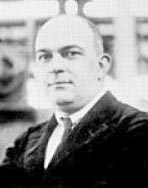
In 1895, Wills, then 17 years old, came to Detroit as an apprentice at the Detroit Lubricator Co. During this time, he took night courses in metallurgy and mechanical engineering. His apprenticeship served, he moved on to the Boyer Machine Co. (later the Burroughs Adding Machine Co.) and became its chief engineer in 1901. In 1902, Wills met Henry Ford, who asked him to work nights on Ford's race cars. When Ford started Ford Motor Company, Wills went along. Wills is credited for first grasping the importance of lightweight, strong, nickel-chrome vanadium steel for use in mass-producing automobiles, allowing Ford to build the Model N in 1907. Wills also played a major part in designing the Model T, designing the planetary transmission and the script "Ford" logo that survives until this day.
In 1919, Wills left Ford. The parting was not entirely amicable, but Wills did have 5.5 million dollars, some from profit sharing but most from his own wise investments in steel factories. Wills used the money to start his own automobile manufacturing firm. C. H. Wills and Co. produced over 1000 vehicles before it shut down in 1922. Wills moved on to found the Wills Sainte Claire Motor Company, which made another 5000 cars in the 1920s before eventually shutting its doors. Wills went to work as a consultant to Chrysler in the 1930s until his death in 1940.
Wills lived in Boston-Edison after purchasing 650 W. Boston, the home originally built for John W. Drake.
Read Wills's bio from the Automotive Hall of Fame, and more about Wills from the Wills Sainte Claire Auto Museum and Hemmings.
DuBois Young
DuBois Young was born in 1879 in Ohio. His family moved to Indianapolis, where at age 14, DuBois began working at the Atlas Engine Works. He moved to other engine companies, and by 1909 he was the general foreman at Premier Engine Works. In 1909, he moved to Jackson Michigan to become a partner in the American Gear and Manufacturing Company. In 1915, Hupp Motor Car purchased American Gear, and Young was made Vice President of Manufacturing at Hupp. In 1924, he was promoted to president of the company. Young served as president of Hupp until 1934, when declining sales and a nasty proxy fight forced him out.
DuBois Young lived at 1197 Longfellow in the 1920s.

